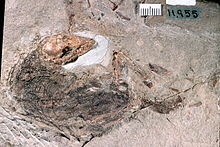| Herpetotherium | |
|---|---|

| |
| H. huntii | |
| Scientific classification | |
| Domain: | Eukaryota |
| Kingdom: | Animalia |
| Phylum: | Chordata |
| Class: | Mammalia |
| Family: | †Herpetotheriidae |
| Genus: | †Herpetotherium Cope, 1873 |
| Type species | |
| †Herpetotherium fugax | |
| Other species | |
| |
Herpetotherium is an extinct genus of metatherian mammal, belonging to the possibly paraphyletic family Herpetotheriidae. Native to North America from the Eocene to Early Miocene, fossils have been found in California, Oregon, Texas, Florida, Montana, Wyoming, Colorado, North and South Dakota, Nebraska, and Saskatchewan.[1] The oldest species, H. knighti, is dated to around 50.3 mya,[2] and the most recent, an unnamed species, may be as recent as 15.97 mya.[1] A morphological analysis of marsupials and basal metatherians conducted in 2007 found Herpetotherium to be the sister group to extant marsupials.[3] It is the youngest known metatherian from North America until the migration of the Virginia opossum from South America within the last 2 million years.[4]

Some authors have regarded the species assigned to Herpetotherium (for instance, H. comstocki, H. marsupium, and H. merriami) as belonging to African and European genus Peratherium Aymard, 1850 on the basis of Simpson's observation that "the upper molars ... agree closely with Peratherium, less closely with other didelphid genera" and on Cope himself recognizing "there is no valid distinction between Herpetotherium and Peratherium" (Simpson, 1928, p. 6) [5][6][7] Yet other authors have continued to maintain generic separation for Herpetotherium and continue to assign new North American species of herpetotheriid marsupials to this genus.[8][9][10][11]
- ^ a b "Taxonomic occurrences of Herpetotherium recorded in the Paleobiology Database". Archived from the original on 30 July 2022. Retrieved 17 December 2021.
- ^ "Taxonomic occurrences of Herpetotherium knighti recorded in the Paleobiology Database". Archived from the original on 30 July 2022. Retrieved 17 December 2021.
- ^ Sánchez-Villagra, Marcelo; Ladevèze, Sandrine; Horovitz, Inés; Argot, Christine; Hooker, Jeremy J.; Macrini, Thomas E.; Martin, Thomas; Moore-Fay, Scott; de Muizon, Christian; Schmelzle, Thomas; Asher, Robert J. (2007). "Exceptionally preserved North American Paleogene metatherians: adaptations and discovery of a major gap in the opossum fossil record". Biology Letters. 3 (3): 318–322. doi:10.1098/rsbl.2007.0090. PMC 2390683. PMID 17426007.
- ^ Bennett, C. Verity; Upchurch, Paul; Goin, Francisco J.; Goswami, Anjali (2018-02-06). "Deep time diversity of metatherian mammals: implications for evolutionary history and fossil-record quality". Paleobiology. 44 (2): 171–198. doi:10.1017/pab.2017.34. hdl:11336/94590. ISSN 0094-8373. S2CID 46796692.
- ^ Simpson, 1928.
- ^ Stock, Chester. "Sespe Eocene Didelphids." Proceedings of the National Academy of Sciences, pp. 122-124, 1935. [Peratherium californicum sp. nov. No. 1943 Calif. Inst. Tech. Vert. Pale. Coll.]
- ^ Krishtalka and Stucky, 1983, p. 232 provides a complete review of synonymy
- ^ Korth, William W. "Review of the marsupials (Mammalia: Metatheria) from the late Paleogene (Chadronian-Arikareean: late Eocene-late Oligocene) of North America." PalZ [formerly Paläontologische Zeitschrift], vol. 92, pp. 499-523, 2018. [Herpetotherium tabrumi sp. nov.]
- ^ Rothecker, Jennifer, and John E. Storer. "The Marsupials of the Lac Pelletier Lower Fauna, Middle Eocene (Duchesnean) of Saskatchewan." Journal of Vertebrate Paleontology, vol. 16, no. 4, pp. 770-774, December 1996.
- ^ West, Robert M. "Fossil mammals from the Lower Buck Hill Group, Eocene of Trans-Peco Texas: Marsupicarnivora, Primates, Taeniodonta, Condylarthra, Bunodont Artiodactyla, and Dinocerata." The Pearce-Sellard Series [Occasional publication of the Texas Memorial Museum, The University of Texas at Austin], no. 35, October 15, 1982.
- ^ Korth, William W., and Jennifer Cavin. "New material of the marsupial (Mammalia, Metatheria) Herpetotherium merriami (Stock and Furlong, 1922) from the John Day Formation, late Oligocene, Oregon, USA." J. Paleontology, vol. 90, no. 6, pp. 1225-1232, 2016.